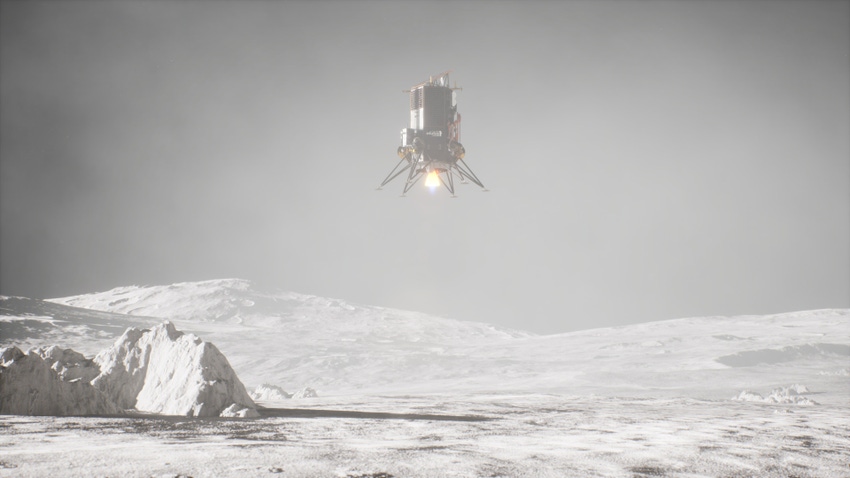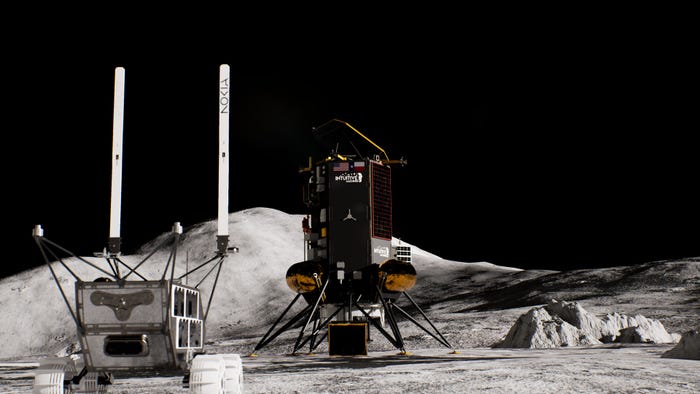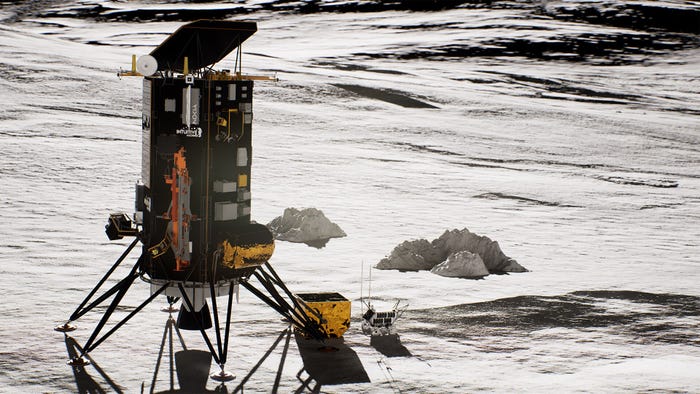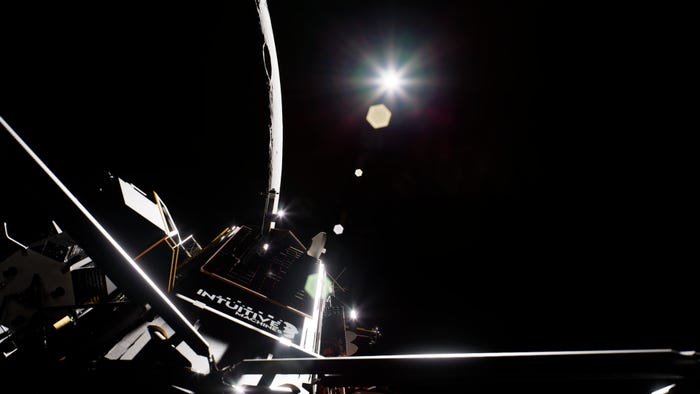Telecoms in space: Nokia’s plan to build networks on the Moon and Mars
DARPA is gathering firms to help it plan a permanent Moon base, ultimately as a springboard to Mars. Nokia, who has been tasked with developing connectivity for it, explains the unique challenges and ambition of the task.
February 1, 2024

Nokia’s research arm, Nokia Bell Labs, was one of 14 organizations recently picked to participate in DARPA’s (The US government’s Defence Advanced Research Projects Agency) LunA-10 Capability Study. The initiative seeks to conjure up a blueprint of how agencies and companies from various industries can be brought together to build out the infrastructure for a permanent base on the Moon, as well as a fully-fledged economy there.
Nokia was selected to work on the telecoms side of things. Essentially its mission is to work out how to hook up a future moon base with a self-maintaining network that can allow IoT space robots and astronauts to stay connected. Separate firms will be sketching out strategies concerning energy, transport, construction and other key elements that might go into constructing a full ‘lunar economy’.
The kit vendor attributes its selection in part to experience gained from an existing mission to build the ‘first cellular network on the Moon’, which is part of NASA’s Tipping Point initiative. It is scheduled to deploy this 4G network in the second half of 2024 in order to prove that 3GPP-based technology can meet communications needs of future lunar and Martian missions.
Nokia Bell Labs’ involvement in the space exploration actually dates back further than that, having provided systems analysis and engineering for every crewed US space program from Mercury to Apollo.

The LunA-10 initiative – how do you build a Moon base?
With regards to LunA-10, the first problem to crunch for the next 10-15 year timeframe is how to set up networks that would allow astronauts to freely communicate directly and with mission control on Earth, transmit video and telemetry data from cameras and sensors spread across the Moon and integrated into spacesuits, vehicles, structures, and scientific experiments.
The firm would supply the connectivity necessary to control robots and automate dangerous tasks on the lunar surface – much like in an IoT mining operation on Earth. It’s ultimately a technology demonstration mission, but the longer-term ambitions stretch to a colony on Mars, no less.
“They [DARPA] were looking for proposals and they selected a number of companies that bring together different aspects of infrastructure,” said Thierry Klein, President of Bell Labs Solutions Research, Nokia Bell Labs. “If you think about infrastructure for [an] economy on the moon, it's not just communication, it's also construction, its mining, its power supply. And ultimately, if you want a functioning lunar economy, with permanent or semi-permanent habitats and a human presence on the moon you need all these elements to work together. And so they're interested in ideas of how to build that out. What are the different elements that you need to build that that lunar economy, but equally importantly, how do the different industry sectors have to work together?
“We provide a network but then the question is, who are the end users for it? It's robot companies that deploy construction robots, mining robots, human presence, scientific payloads. They're really the stakeholders in the economy that benefit from the network, and the communication capabilities we deploy, or we develop. And then of course, we have dependencies, from how do you power the equipment that we deployed? Where do you mount the equipment? Is this mounted on a human habitat, is it mounted on the equivalent of tower structures that you have on earth?
“I think they received over 260 or so applications, they ended up selecting 14 companies through this programme. And we're very, very fortunate, very honoured that we're one of one of the 14 companies. The programme started at the end of last year, and it's running until the middle of this year with companies working on that project, but also talking to other companies to really make sure that these pieces of a multi sector infrastructure fit together.”
What would a Moon base actually be for?
After the heyday of Neil Armstrong, the Apollo Missions and all the rest of it, for a long time it looked like manned exploration of space was dropping down the list of priorities for various national governments, most importantly of course the US. However relatively recently the rhetoric around it at least has ramped up considerably. Not so long ago, a plan to deploy RAN equipment on the moon’s surface would have seemed like the sort of tiresome thing tech journos find in their inboxes on 1 April – but here we are in 2024 and the plans are real. But what would an actual base on the Moon look like? What would it be for?
“In general, it's going to be a mix of government missions and commercial missions,” continues Klein. “Certainly if you look at the Artemis programme in the US, that's all about going back to the Moon with human spaceflight. Initially it will be short missions but then over time the missions will get longer and we'll move towards maybe a semi-permanent presence on the lunar surface. I think there's also a lot of commercial missions, a lot of commercial providers, that are thinking of going to the Moon, really for science, technology, exploration, but also mining and so forth. So I think the general vision in the space industry is that within the next 10-15 years or so, we would have permanent/semi-permanent human presence on lunar surface in some form of human habitats, but then augmented a lot with robotic assets – because for resource mining, mining for materials, also to sustain the human presence, as well as construction and so forth, you can't do that all with astronauts.
“There's a view that there will be a lot of robotic assets that will need to be deployed to build out the human habitats, as well as then for scientific experiments, digging, drilling, resource mining, and so forth. And then when we look at it, if that's the future that we see in 10-15 years, all of these applications will require a lot of communication. There'll be, of course, voice because we'll have human presence. But there will be large number of sensors, machines, robots, cameras, that will need to communicate, collect data, share the data with each other.
“We think of this lunar economy as really requiring a lot of voice, video and data applications that that we quite frankly see on earth and we see in enterprise and industrial environments. When I think about the lunar economy, it's not that different from a mine in Australia, where you also have people but you have robotic assets, you have machinery, you have equipment, you have sensors, and it's a geographically contained area where you need to provide these capabilities.
“You might be in a remote area, but locally you need to connect all the people and machines and sensors and devices. And so the moon is quite similar in how we think about it from a setup. It just happens to be very far away, which brings challenges. It happens to be a very, very harsh environment, which brings challenges as well from how you build and how you deploy and how you operate the equipment.”

The challenges of building telecoms in space
There may be some experiential overlap to be extracted from terrestrial private network deployments when it comes to hooking up the moon with internet, but there are of course a ton of differences not just in leaving the earth’s surface with the equipment, but managing it once it’s there. When a 5G tower goes down in Surry, you can send out an engineer with a toolbox. When the outage occurs in the Sea of Tranquillity, it’s not quite so simple.
“The two main challenges are, of course, the environment – from temperature, radiation the environment is very, very different,” says Klein. “Much, much harsher. Also just sending the equipment to the moon – you put equipment on the rocket, and you have different shock, vibration, acceleration, constraints that the equipment has to withstand. So those are the environmental factors you have to take into account – and then you have to be able to completely autonomously upgrade this network. Because either you're supporting an uncrewed mission and you don't have astronauts – and some of the missions, whether it's government or commercial missions, might be uncrewed – so you need a network that's operational fully functioning even without human intervention or human intervention from Earth, and remotely configure and operate a network.
“Or on the other side, you may have astronauts on the Moon but their mission is not to be a telecom network operator. They have their primary mission, time is super precious. So that network needs to be self-configuring, self-optimising, self-managing. Because you either don't have people that can maintain it or it's not their main job. So that also changes completely how you how you build, operate, maintain, reconfigure the network.
“Reliability will be key because also we have astronauts and their lives depend on it. It changes the operational parameters a little bit, but ultimately the underlying technology of how you send information, we can absolutely leverage all the 3GPP technologies that we've deployed on Earth. That's actually the main premise, why not leverage the technologies that we've developed, that the telecom industry has invested in, that are deployed at large scale that millions of users use every day? Why not leverage those technologies for space applications, but take into account the particular aspects of the environment to harden and adapt the technology for space?”
‘A stepping stone to Mars’
As if the nuts and bolts of setting up a fully connected colony on the Moon wasn’t enough of a problem to chew on, the ambitions for the entire endeavour extend to doing something similar on Mars – something Space X founder Elon Musk has also expressed as a goal.
“I think the lunar deployment is really just a stepping stone to Mars, and it's very, very similar, says Klein. “NASA has this ‘Moon to Mars’ programme, where they really talk about the moon being a goal in itself but also being a stepping stone towards ultimately going to Mars. Again, when we look at the use cases and the application scenarios, it's very similar between the Moon and Mars. How you envision astronauts going to Mars initially, because it's such a long journey, they might stay for longer on the surface as opposed to just going and coming right back because the journey is so long. That feels very similar to the next missions over the next 5-10 years on the lunar surface. And then ultimately, the missions will also get longer, but it will still be in this context of a small regional area where you have the presence on the Martian surface.
“Some of the challenges will be even bigger because of the additional delay from Earth to Mars. So I think it will become even more important for these networks to be self configuring just based on their round trip time, even the speed of light and propagation of a signal from Earth to Mars… you can't really rely on that – if that’s what it takes to reconfigure a network, you'll be offline for quite a bit, just for the signal to propagate.
"Same thing with robotic assets. All of that will have to be managed locally if you want robots to be controlled by a network, it has to be managed locally from the network and maybe an edge compute infrastructure that’s attached to the network locally on the surface. Because you can't remotely control robots from Earth to Mars, it will just take too long. So because of the delay, from Earth to the Moon or Earth to Mars, you will end up building more local communication and compute capability so that everything is sort of at the edge. But the use cases and the performance scenarios will be very similar on Mars.”

About the Author(s)
You May Also Like











_1.jpg?width=300&auto=webp&quality=80&disable=upscale)


.png?width=800&auto=webp&quality=80&disable=upscale)